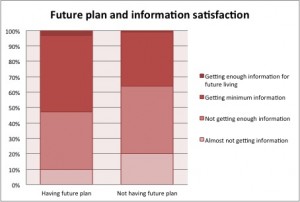Namie Town aggressively takes measures for strengthening communications with its residents.
Reconstruction Agency of the Japanese government conducted a resident intention survey for Namie Town in Fukushima prefecture, which is located just in north of Fukushima Daiichi nuclear power plant. Many of news media reported that 30 percent of the resident don’t want to return to their home town even after the evacuation instruction is lifted. However, taking it positively, it means the other 70 percent may possibly wish to go back home.
What would be required for the evacuees to go back home? I think communications between the evacuees and the town government authority is essential. On the prospects of the reconstruction activities, in particular, the communications, just like the radiation risk as well, are so important for evacuees to imagine their stable and safe lives in the town.
The survey shows that their prime concerns to think of their homecoming are on recovery status of their life line infrastructures, such as water & sewage systems, medical facilities as well as supermarkets and other commercial facilities, while the most of the evacuees currently feel it unable to imagine their lives or their future in the home town. The municipal government, of course, has some plans to respond to relieve these concerns. Other than creating a new plan, however, it is imperative for the government transparently and timely to disclose and convey to the evacuees how the reconstruction works are going on. Knowing the updated status information, they will be encouraged to think of their homecoming.
There would be two major directions as realistic measures. One is to have recovery support staffs to go around for communications with the evacuees on a face to face basis. The Namie municipal government already placed the support staffs to Chiba and Yamagata prefectures, and from April, it will assign more staffs to Niigata, Saitama and Kyoto. This effort would have to be done by other municipalitis as well. The second approach is effectively to use Information Technology. Recently, Google opened Street View of the evacuation zones of Namie Town to the public. With the new tool, the evacuees can see and confirm by themselves the current status of the town, not just relying on often biased information by the conventional media. These two approaches are just in an initial phase. Every possible measure has to be taken to keep the evacuees updated about their home town.
In March, the a No-Entry area in Namie was realigned to lift restrictions on temporary entry from April. But more than a few years will be required until people can be permanently homecoming. There will be a long way to go, therefore during the long evacuation period, keeping the close communications is absolutely important to enable the people to understand the prospects of the reconstruction activities so to plan and imagine their future lives in the home town.
Written in Japanese by Retz Fujisawa (RCF Reconstruction Support Team)
Translated by Akio Saito






